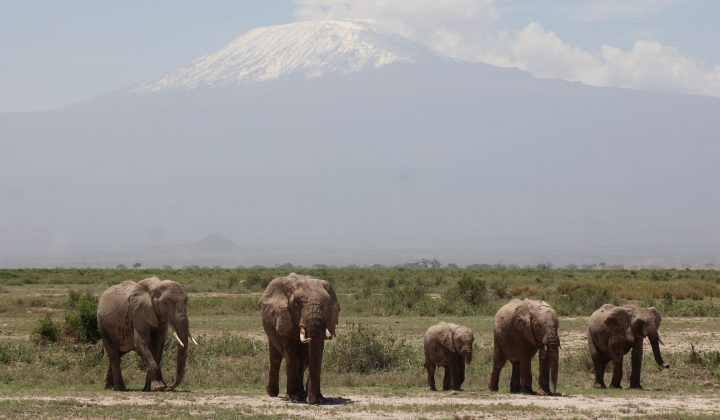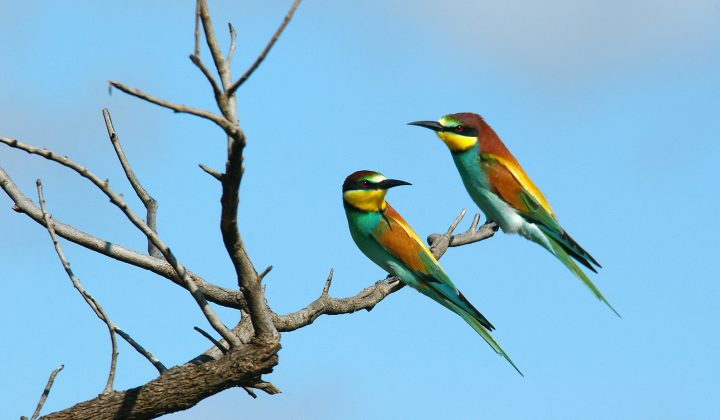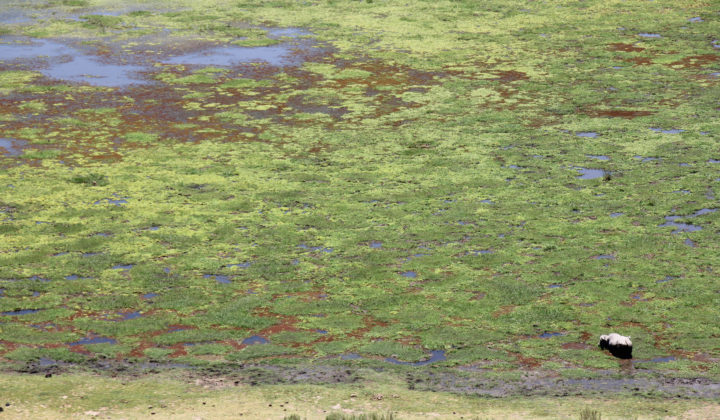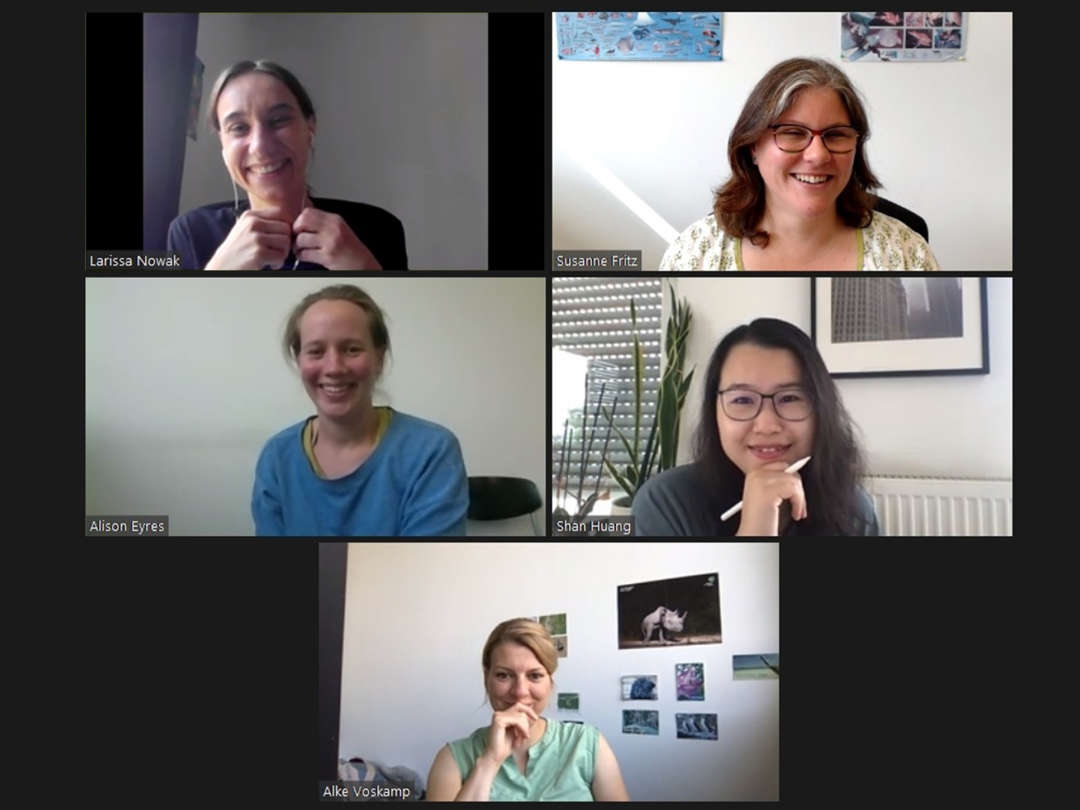
Leitung
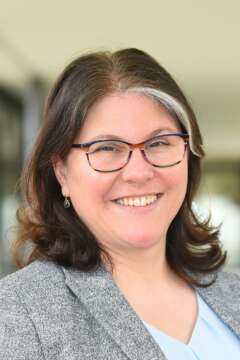
Speaker of Research Field "Biodiversity and Climate"
Research interests
I am interested in large-scale evolutionary, paleontological, biogeographic, and (paleo-)ecological patterns, their relationships with the abiotic environment in time and space, and the processes underlying these patterns and relationships. I have worked on ecology, evolution and conservation of mammals, amphibians and birds. Particularly since the establishment of my own research group (Emmy Noether fellowship of the German Research Foundation DFG), my research focuses on macroevolution, macroecology, and biogeography of living and fossil birds and mammals. Since starting my professorship at Goethe University Frankfurt I increasingly develop interdisciplinary research in cooperation with experts in the reconstruction of paleoclimate and Earth surface dynamics, with the goal of understanding the effects of climate change and mountain building on biodiversity dynamics.
Publications
Researcher ID and Publons
Google Scholar Profile
OrcID
Full publication list [PDF]
Honorary positions
Editorial Board member at Proceedings of the Royal Society B: Biological Sciences, since 2017
Subject Editor at Ecography, since 2014
Associate Editor at Frontiers of Biogeography, since 2013
Substitute member of the Examination Board for BSc and MSc in Geosciences at Goethe University Frankfurt, since 2021
Elected member of the Scientific Committee of the Senckenberg Gesellschaft für Naturforschung, 2021-2024
Board member, Synthesis Centre for Biodiversity Sciences sDiv at the German Centre for Integrative Biodiversity Research iDiv, Leipzig, Germany, 2018-2021
Teaching at Goethe University Frankfurt
Please see my university webpage for more information
Academic CV
Since 2021 Professor for Geobiodiversity Resarch at the Institut für Geowissenschaften, Fachbereich Geowissenschaften / Geographie, Goethe-Universität Frankfurt; Leibniz Professorship in cooperation with Senckenberg Gesellschaft für Naturforschung
2014-2021 Emmy Noether research group leader, Senckenberg Biodiversity and Climate Research Centre & Fachbereich Biowissenschaften, Goethe-Universität Frankfurt
2011-2014 Postdoctoral researcher, Biodiversity and Climate Research Centre (BiK-F) & Senckenberg Gesellschaft für Naturforschung, Frankfurt, Germany
2009-2011 Postdoctoral researcher, Center for Macroecology, Evolution and Climate, University of Copenhagen, Denmark
2009 PhD degree, Imperial College London, UK. Thesis „Comparative analyses of extinction risk in vertebrates”
2006-2009 Marie Curie Early-Stage Researcher at Imperial College London. EU FP6 project „HOTSPOTS – Understanding and conserving the Earth’s biodiversity hotspots”
1999-2005 Diplom in Biology, Eberhard Karls University Tübingen, Germany
Mitglieder

Research interests
I am a geologist interested in dating sedimentary records and reconstructing terrestrial paleo-environments, especially during warm greenhouse periods such as the Eocene. These terrestrial records are key in providing constraints on dust fluxes and precipitation in the past, especially when accurately dated by using magneto- and cyclostratigraphy. I employ a variety of sedimentological tools such as grain-size distributions and surface textures to track mineral dust and aridification in the geological record (as described in Meijer et al., 2020; Earth-Sci. Rev.). Furthermore, I am using stable and clumped isotopes to reconstruct temperature as well as precipitation and study their role in driving biotic changes.
The middle Miocene Climate Transition in Europe
The mMCT at ~14 Ma is characterized by atmospheric cooling and the growth of the West Antarctic ice sheet. This may have had major implications for ocean circulation and precipitation patterns, especially in Europe where westerly moisture is controlled by pressure systems over the Atlantic Ocean. I aim to explore these precipitation patterns across the mMCT by measuring the stable and clumped isotopes in high-resolution terrestrial records in Spain and compare these with various other records throughout Europe.
North American Paleoclimate and Biodiversity Evolution
The continental basins in the north-western US provide a rich fossil mammal record marked by multiple shifts in biodiversity during the Eocene period. I aim to reconstruct the climatic evolution of the Paleogene basins in Idaho and Montana by using stable and clumped isotopes to understand the links between climate and mammal biodiversity.
More info
East Asian monsoons during the Eocene
Monsoons are a characteristic feature of the modern-day Asian climate, yet their geological history remains debated. I have dated sedimentary records from the Xining Basin in central China using magnetostratigraphy to study the evolution of the monsoons during the Eocene period. I use various sedimentological, geochemical and palynological proxies to track atmospheric moisture and dust storms to study the evolution of the monsoons and westerlies.
More info
East Asian monsoons during the Eocene
Monsoons are a characteristic feature of the modern-day Asian climate, yet their geological history remains debated. I have dated sedimentary records from the Xining Basin in central China using magnetostratigraphy to study the evolution of the monsoons during the Eocene period. I use various sedimentological, geochemical and palynological proxies to track atmospheric moisture and dust storms to study the evolution of the monsoons and westerlies.
Duration of the Paleocene-Eocene Thermal Maximum (PETM)
The PETM is arguably the most famous and well-studied climatic event in Earth’s history and serves as an analogue for future global warming. This hyperthermal event has been recorded in the orbitally-forced terrestrial deposits of the Bighorn Basin, Wyoming US, at high-resolution which enabled improved estimates on the duration of the PETM.
CV
Professional Experience
2020-current: Postdoc at Senckenberg Biodiversity and Climate Research Centre, Frankfurt, Germany
Education
2015-2020: University of Potsdam, Germany, Geosciences, Ph.D.
2013-2015: Utrecht University, the Netherlands, Earth Sciences, M.Sc.
2010-2013: Utrecht University, the Netherlands, Earth Sciences, B.Sc.
RESEARCH INTERESTS
My research interests are mainly focused around the conservation of biodiversity and, in particular, assessing the impacts of environmental change on species distributions and diversity patterns. So far, my research has comprised different aspects of conservation work, from modelling a single species distribution, with the aim to support conservation actions, to global conservation assessments. My recent work has been largely focused on assessing the impacts of climate and land-use change on terrestrial vertebrate distributions, ranging from potential changes in global biodiversity patterns to changes in local species community compositions. Currently I am working on a project in collaboration with the Frankfurt Zoological Society to identify global sites of conservation interest, that have a high potential for successful long-term conservation.
EXTERNAL LINKS
ResearchGate Profile
Google Scholar Profile
ORCID ID
Short CV [PDF]


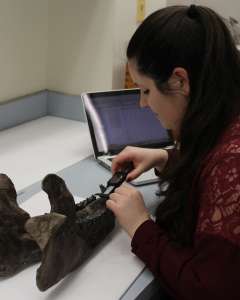
I am fascinated by how and why both taxonomic and ecomorphological diversity are so unevenly distributed across the tree of life. Why do some clades comprise just a few ecomorphologically similar species, while others are made up of thousands of species with disparate ecologies and morphologies spread across all corners of the globe? Why do some clades or ecomorphological traits pass through extinction events relatively unscathed, while others are decimated to extinction? What biotic and abiotic factors drive these patterns to ultimately shape the biodiversity we see throughout geological history and today? To date, I have worked primarily on the evolution of mammals through time, using mostly fossil but also extant datasets of taxonomic occurrence and ecomorphological trait data. Mammals evolved over 200 million years ago, carving out niches alongside the dinosaurs for much of their evolutionary history. Mammals survived the mass extinction that killed all non-avian dinosaurs, and underwent a major adaptive radiation, becoming arguably the most important tetrapod group in Cenozoic land vertebrate ecosystems. For this reason, the Cenozoic is often referred to as the ‚Age of Mammals‘. Throughout their evolutionary history, perturbations in the macroevolutionary patterns of mammals have been significantly linked to changes in Earth’s climate and environment. Through my work I aim to both quantify these long-term patterns of mammal evolution, as well as better understand what drives these patters. To do this, I use a suite of statistical methods in conjunction with large datasets, and take an interdisciplinary approach in order to understand patterns and drivers of macroevolution holistically, exploring interactions between the Geosphere and the Biosphere.
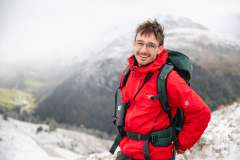
Alumni
Research interests
I am interested in understanding the ecological and evolutionary processes that drive patterns of biodiversity. One major factor influencing the distribution of species is climate. As such, my current research focusses on the dynamics of climatic niches in birds.
One-fifth of birds (~2000 species) migrate seasonally between breeding and wintering grounds. However, many studies of climatic niches use only breeding distribution and year-round climate data, ignoring seasonal dynamics in climate and distribution. For my PhD project, I am using breeding and wintering range maps to characterise and compare climatic niches inhabited by migratory birds during each season in order to determine whether migratory birds track a single climatic niche throughout the year. The results have implications for understanding the drivers of seasonal movements and the evolution of both climatic niches and migration.
Understanding the current climatic niches of birds will allow me to investigate the interplay between past climatic conditions, climatic niche evolution and diversification. I am using current climatic niches obtained from my analyses of migratory birds in combination with phylogenies in order to determine whether climatic niche evolution is related to paleo-climatic conditions, and whether there is there a relationship between the rate of climatic niche evolution and clade diversification.
CURRENT POSITION
Since Nov 2014 PhD student at the Senckenberg Biodiversity and Climate Research centre (BiK-F)
Project: Ecology and evolution of climatic niches in birds Supervisor: Dr Susanne Fritz
EMPLOYMENT HISTORY AND EDUCATION
2013-2014 MSc Plant Diversity (graduated with distinction) University of Reading_
Master’s thesis: Climatic niche evolution in the genus Hypericum
Supervisors: Dr Mark Carine (NHM) & Dr Alastair Culham (University of Reading)
June-August 2013 Leonardo Da Vinci mobility grant University of Evora
Working on the TytoTagus project: Seeking to understand why there are such a large number of Barn Owls concentrated around
the Tagus estuary.
2012-2013 Senior Research Technician University of Warwick
Investigating plant pathogen interactions using Arabidopsis thaliana and the oomycete Hyaloperonospora arabidopsidis as a
model system.
2011-2012
Senior Research Technician University of Warwick
Investigating cell specific gene expression in Arabidopsis thaliana
11-12 2010 Work experience University of Cambridge
Transposon mutagenesis and mutant screens in order to understand the genetic regulation of virulence and quorum sensing in
the plant bacterial pathogen Erwinia caratovora.
2007-2010 B.A.(Hons.) Biological Sciences (2.i) University of Oxford
Relevant finals modules: Evolution & Systematics, Environmental Biology, Quantitative Methods
2005-2007 A levels (4 As) Hills Road, Cambridge
Biology, Maths, Geography, Chemistry
Bowden SD, Eyres A, Chung JCS, Monson RE, Thompson A, Salmond GPC, Spring DR, Welch A. (2013) Virulence in
Pectobacterium atrosepticum is regulated by a coincidence circuit involving quorum sensing and the stress alarmone, (p)ppGpp.
Molecular Microbiology. Volume: 90 Issue (3) p.457-471.
Gronlund J.T, Eyres A, Kumar S, Buchanan-Wollaston V, Gifford ML. (2012) Cell specific analysis of
Arabidopsis leaves using fluorescence activated cell sorting. Journal of Visual Experiments (JoVE). Issue: 68
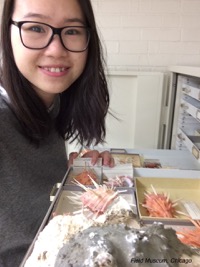
Research interests
Biodiversity – Macroecology & Macroevolution
I am interested in understanding broad-scale biodiversity dynamics, in space and time, particularly the dramatic temporal and spatial variation in different aspects of biodiversity. I investigate the processes underlying biodiversity patterns, with an emphasis on the role of history in shaping global and regional biota, including evolutionary history of the organisms and historical environmental transitions (e.g. landscape evolution and paleoclimate change).
I take an interdisciplinary approach to research by synthesising large datasets from ecology, evolution, palaeontology, geoscience, etc. I also integrate knowledge from studying various organismal systems, including terrestrial mammals, marine bivalves, and parasites.
Funded by a DFG Eigene Stelle grant, my current work combines cross-continent paleontological and neontological data of terrestrial large mammals to investigate the macroevolution of body size in relation to ecological functions and environmental transitions.
See more on my Research website.
Education
2012 PhD University of Georgia, USA
2006 MSc Imperial College London, UK
Post-PhD Positions
2015-2019 Alexander von Humboldt Postdoctoral Fellow, Senckenberg Biodiversity & Climate Research Centre, Germany
2012-2005 Postdoctoral scholar, University of Chicago, USA
See more on my full CV.
Selected Publications
Song, H., Huang, S., Jia, E., Dai, X., Wignall, P. B., Dunhill, A. M., (2020). “Flat latitudinal diversity gradient caused by the Permo-Triassic mass extinction”. Proceedings of the National Academy of Sciences USA. URL: https: //doi.org/10.1073/pnas.1918953117.
Teitelbaum, C. S., Amoroso, C. R., Huang, S., Davies, T. J., Rushmore, J., Drake, J. M., Stephens, P. R., Byers, J. E., Majewska, A. A., Nunn, C. L., (2020). “A comparison of diversity estimators applied to a database of host- parasite associations”. Ecography. URL: https://doi.org/10.1111/ecog.05143.
Huang, S., Meijers, M. J., Eyres, A., Mulch, A., Fritz, S. A., (2019). “Unravelling the history of biodiversity in moun- tain ranges through integrating geology and biogeography”. Journal of Biogeography 46.8, pp. 1777–1791. URL: https://doi.org/10.1111/jbi.13622.
Edie, S. M., Huang, S., Collins, K. S., Roy, K., Jablonski, D., (2018). “Loss of biodiversity dimensions through shifting climates and ancient mass extinctions”. Integrative and Comparative Biology 58.6, pp. 1179–1190. URL: https: //doi.org/10.1093/icb/icy111.
Huang, S., Eronen, J. T., Janis, C. M., Saarinen, J. J., Silvestro, D., Fritz, S. A., (2017). “Mammal body size evolution in North America and Europe over 20 Myr: similar trends generated by different processes”. Proceedings of the Royal Society B: Biological Sciences 284, p. 20162361. URL: https://doi.org/10.1098/rspb.2016.2361.
